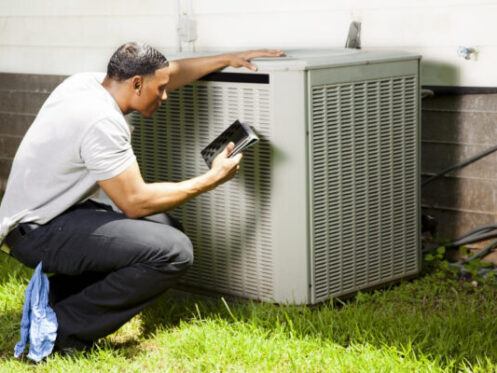The reset button is a small component that plays a crucial role in the operation of HVAC units. Before attempting to use the reset button, turning off the power supply to your HVAC unit is essential. Read on to discover the functions and other vital details about the reset button.
Where Is the Reset Button?
The reset button’s location depends on the make and model of the HVAC unit. It usually resembles a metal box with cooling fins and is connected to the indoor unit — furnace or air handler — through refrigerant lines and electrical cables. The reset button is often positioned near the electrical access panel, a removable cover that protects the electrical components of the condenser.
Purpose of the Reset Button
The reset button is a safety feature that helps protect your HVAC unit from potential damage or malfunctions. It provides a way to troubleshoot and address minor problems that may cause your HVAC unit to shut down unexpectedly. When the unit detects an abnormal condition that could potentially harm it or compromise efficiency, it triggers an automatic shutdown, and the reset button is activated.
The reset button isn’t a permanent solution to any underlying problems your unit has. It’s a temporary fix to get the unit back up and running. If the issue persists and requires frequent resets, it’s an indication that your unit has an underlying problem that may need to be addressed with an HVAC repair service.
When to Use the Reset Button
Power Surges and Temporary Glitches
These events can disrupt your HVAC unit’s normal functioning and cause it to shut down unexpectedly. In such cases, pressing the reset button allows the unit to restart and often resolves the problem, restoring the HVAC unit to its normal functioning.
Freezing or Overheating
If your HVAC unit’s evaporator coils freeze or it starts overheating, it might automatically shut down as a protective measure. Clogged air filters, blocked vents, or insufficient airflow can cause these issues. Once you’ve addressed the root cause of the freezing or overheating, pressing the reset button helps ensure the unit resumes normal operation.
Sensor or Thermostat Errors
HVAC units rely on various sensors and a thermostat to efficiently regulate indoor temperatures. Occasionally, these sensors may malfunction or encounter errors, causing the unit to shut down unexpectedly. Before pressing the reset button, check for any sensor-related issues, and replace faulty sensors if necessary. Once the underlying problem is resolved, the reset button helps restore the unit’s normal functioning capabilities.
System Lockups and Software Glitches
Modern HVAC units often come with complex electronic control systems, and like any software-driven device, they can experience occasional lockups or software glitches. If your HVAC unit becomes unresponsive or fails to function as expected, using the reset button might reset the system and resolve minor software-related problems.
After Maintenance or Filter Replacement
Resetting the unit after maintenance ensures that it restarts and continues operating with the updated settings, allowing it to function optimally with the newly installed components.
Preventing Reset Button Occurrences
Regular Maintenance
During an HVAC maintenance visit, our professional technicians will inspect and clean your HVAC unit, identify potential issues, and perform the necessary repairs or adjustments. Regular maintenance ensures all HVAC components work correctly, reducing the likelihood of premature system shutdown.
Air Filter Replacement
A clogged or dirty air filter restricts airflow, leading to overheating and system shutdown. Regularly inspecting and replacing your air filters is crucial to preventing the reset button from being triggered. Depending on usage and filter type, change your air filters every one to three months.
Proper Ventilation and Airflow
You should ensure that the outdoor unit of your HVAC system has sufficient clearance and is free from any obstructions. Proper ventilation and airflow around the unit are essential for optimal operation. Ensure no leaves, debris, or furniture are blocking the vents, as restricted airflow can cause the system to overheat and trigger the reset button.
Thermostat Settings
Monitor your thermostat settings to ensure they are appropriate for the current season and your comfort needs. Drastic temperature changes, constant adjustments, or setting the thermostat too high or too low can strain your HVAC unit and result in sudden shutdowns. Consider using a programmable thermostat for better control and improved energy efficiency.
Consult a Professional
When it comes to reliable HVAC services, El Indio AC stands out as a top-notch HVAC contractor. With a team of skilled technicians and more than 20 years of experience in the HVAC industry, we have garnered a reputation for exceptional customer service and expertise. From routine maintenance and repairs to system installations and energy-efficient upgrades, our comprehensive offerings ensure that your home or business remains comfortable all year round. Contact El Indio AC today and get access to a whole suite of HVAC solutions in Tolleson.


